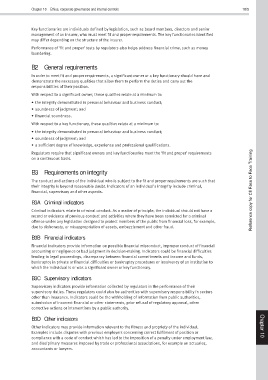Page 157 - W01TB8_2017-18_[low-res]_F2F_Neat
P. 157
Chapter 10 Ethics, corporate governance and internal controls 10/5
Key functionaries are individuals defined by legislation, such as board members, directors and senior
management of an insurer, who must meet fit and proper requirements. The key functionaries identified
may differ depending on the structure of the insurer.
Performance of ‘fit and proper’ tests by regulators also helps address financial crime, such as money
laundering.
B2 General requirements
In order to meet fit and proper requirements, a significant owner or a key functionary should have and
demonstrate the necessary qualities that allow them to perform the duties and carry out the
responsibilities of their position.
With respect to a significant owner, these qualities relate at a minimum to:
• the integrity demonstrated in personal behaviour and business conduct;
• soundness of judgment; and
• financial soundness.
With respect to a key functionary, these qualities relate at a minimum to:
• the integrity demonstrated in personal behaviour and business conduct;
• soundness of judgment; and
• a sufficient degree of knowledge, experience and professional qualifications.
Regulators require that significant owners and key functionaries meet the ‘fit and proper’ requirements
on a continuous basis.
B3 Requirements on integrity
The conduct and actions of the individual who is subject to the fit and proper requirements are such that
their integrity is beyond reasonable doubt. Indicators of an individual’s integrity include criminal,
financial, supervisory and other aspects. Reference copy for CII Face to Face Training
B3A Criminal indicators
Criminal indicators relate to criminal conduct. As a matter of principle, the individual should not have a
record or evidence of previous conduct and activities where they have been convicted for a criminal
offence under any legislation designed to protect members of the public from financial loss, for example,
due to dishonesty, or misappropriation of assets, embezzlement and other fraud.
B3B Financial indicators
Financial indicators provide information on possible financial misconduct, improper conduct of financial
accounting or negligence or bad judgment in decision-making. Indicators could be financial difficulties
leading to legal proceedings, discrepancy between financial commitments and income and funds,
bankruptcy in private or financial difficulties or bankruptcy procedures or insolvency of an institution to
which the individual is or was a significant owner or key functionary.
B3C Supervisory indicators
Supervisory indicators provide information collected by regulators in the performance of their
supervisory duties. These regulators could also be authorities with supervisory responsibility in sectors
other than insurance. Indicators could be the withholding of information from public authorities,
submission of incorrect financial or other statements, prior refusal of regulatory approval, other
corrective actions or interventions by a public authority.
B3D Other indicators Chapter
Other indicators may provide information relevant to the fitness and propriety of the individual.
Examples include disputes with previous employers concerning correct fulfilment of position or 10
compliance with a code of conduct which has led to the imposition of a penalty under employment law,
and disciplinary measures imposed by trade or professional associations, for example on actuaries,
accountants or lawyers.

